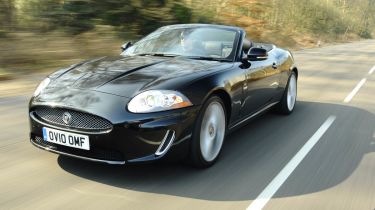Jaguar XK Convertible
The Older Jag has a distinct power advantage, Is old-fashioned muscle enough to keep Brit on top?
Four seats, a convertible roof, comparable price and front-engined, rear-wheel-drive layout... You could be forgiven for thinking BMW’s new 6-Series Convertible has a lot in common with Jaguar’s latest XK drop-top. However, in reality the cars couldn’t be more different.
Parked side-by-side with its rival, the Jag looks like a true Brit thoroughbred. With its styling overhauled in 2009 the XK is a stunning drop-top – it’s mean and menacing from every angle. Traditional sports car styling is welcome on the outside, but less successful inside. Climb into the Jaguar after the 640i, and you feel a bit like you’re going back in time. The seats aren’t as supportive, while the dash is less advanced.
The fact there are fewer buttons scattered across the centre console will be a plus point for many drivers, but the old-fashioned graphics and small screen of the sat-nav and cabin control system are put to shame by the BMW’s widescreen set-up. And then you glance over your shoulder at the rear seats. Legroom is all but non-existent here, making the two upright buckets of use only for small children and shopping bags.
But before you write off this test as one-sided, something very special happens when you press the Jaguar’s engine start button. The 5.0-litre V8 rumbles into life like a NASCAR racer’s.
At any speed, the powerplant resonates and growls with a wonderfully responsive soundtrack. And that noise is accompanied by astonishing pace. Doing without the infinitely adjustable settings of the BMW, the Jag simply launches itself forward with every touch of the incredibly sensitive accelerator pedal.
Our 0-60mph sprint took a mere 5.2 seconds, and the XK felt as though it was only just getting into its stride on our track test at 70mph. It’s hard to see how anyone would need the extra pace offered by the hotter XKR model... Despite having two fewer gears than its eight-speed rival, the Jaguar’s auto is still a top performer.
Both models offer paddleshift manual modes, but the XK’s six ratios are far more intuitive to select at speed. What’s more, the Sport setting offers the perfect high-performance self-shifting mode, even changing into lower gears when slowing down quickly in order to apply engine braking.
Enter a fast corner, though, and the Jag begins to lag behind its competitor. There’s a softness to all the controls that’s reflected in the chassis set-up – great for a comfortable straight-line ride, yet not so good on tight turns when the body rolls and the unladen inside rear wheel starts to spin uselessly.
So does the XK feel completely outclassed? No. What it lacks in advanced chassis set-ups and electronic gadgets it makes up for with brute force and character. Yes, it costs £4,255 more than its six-cylinder rival, but it also weighs in at £3,520 less than BMW’s V8-powered 650i SE Convertible. This car is a joy to drive, yet making the most of itspower does come at a price...
Official combined fuel economy of 25.2mpg will start to look extremely optimistic as soon as you start to enjoy this Jaguar’s finest asset – its engine.
Details
Chart position: 2
WHY: Big cat has V8 soundtrack to match its sleek looks. It mixes brutal performance and relaxed cruising with a priceless ability to make every trip an event.







